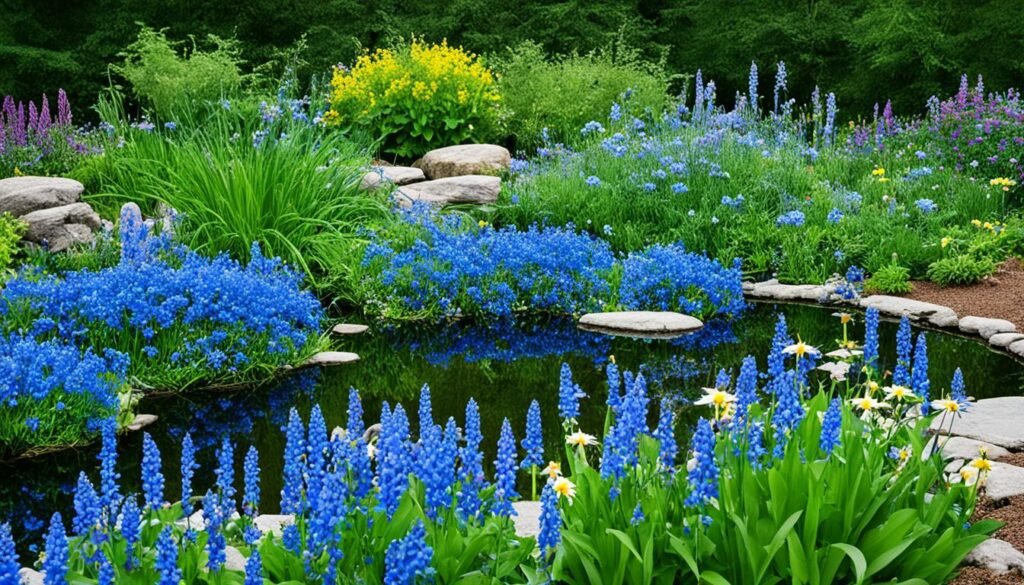Imagine stepping into a lush garden, the air filled with the sweet fragrance of blooming flowers. As you walk through the vibrant landscape, your eyes are drawn to a stunning display of blue flowers, their petals shimmering with dewdrops under the morning sun.
This is the kind of magical scene that blue flowers can create in your garden, even in wet soil conditions. When faced with soggy or damp soil, many gardeners might assume that their options for colorful flowers are limited. But fear not! There are plenty of blue flowers that thrive in these moist conditions, transforming your garden into an oasis of beauty.
Whether you’re looking for perennial plants, annuals, ground covers, or even container plants, there is a wide variety of blue flowers that can thrive in wet soil. From delicate blooms to bold, statement flowers, you can find the perfect blue additions to complement your garden’s unique style.
Not only do these blue flowers add a pop of color to your landscape, but they also offer several benefits. Blue flowers have a calming effect, creating a soothing atmosphere in your garden. They can also attract pollinators, such as butterflies and hummingbirds, bringing vibrancy and life to your outdoor space.
In this article, I will guide you through the best blue flowers for wet soil conditions. Whether you have a perpetually damp garden or a specific area with standing water, there is a blue flower that’s perfect for you. Let’s explore the top choices and learn how to care for them to ensure they thrive in their watery surroundings.
Key Takeaways:
- There are many blue flowers that can thrive in wet soil conditions.
- Perennial plants, annuals, ground covers, and container plants are all options for adding blue flowers to your garden.
- Blue flowers in wet soil can create a calming atmosphere and attract pollinators.
- Proper care, including providing adequate drainage and regular watering, is essential for the health of blue flowers in wet soil.
- Pairing blue flowers with companion plants can enhance the beauty of your garden.
Perennial Blue Flowers for Wet Soil
If you have wet soil conditions in your garden, perennial blue flowers can be a fantastic choice. These plants are hardy and can endure standing water, thriving in moist environments. With their vibrant blue colors, they can add a striking and beautiful element to your landscape year after year.
There are several popular blue perennial flowers that are well-suited for wet soil conditions. Here are a few examples:
“The cardinal flower (Lobelia cardinalis) is known for its intense blue blossoms and can thrive in wet soil.”
“The corkscrew rush (Juncus effusus spiralis) features unique twisted foliage and produces small, blue flowers in wet areas.”
“Creeping Jenny (Lysimachia nummularia) is a low-growing plant with trailing stems and bright blue flowers, making it an excellent choice for wet ground.”
“Elephant’s ears (Colocasia esculenta) not only have large, heart-shaped leaves but can also produce blue flowers that enhance the aesthetics of wet soil areas.”
These perennial blue flowers can thrive in wet soil conditions and provide a stunning visual display in your garden. Their resilience and ability to tolerate standing water make them an ideal choice for damp areas.
| Perennial Blue Flowers | Description |
|---|---|
| Cardinal Flower (Lobelia cardinalis) | A vibrant blue flower that thrives in wet soil conditions. |
| Corkscrew Rush (Juncus effusus spiralis) | A unique plant with twisted foliage and small blue flowers. |
| Creeping Jenny (Lysimachia nummularia) | A low-growing plant with trailing stems and bright blue flowers. |
| Elephant’s Ears (Colocasia esculenta) | A plant with large, heart-shaped leaves and blue flowers. |
These perennial blue flowers are just a few examples of the many options available for wet soil conditions. With their resilience and beautiful colors, they can transform your garden into a stunning oasis.
Why Choose Perennial Blue Flowers for Wet Soil?
Perennial blue flowers not only add visual appeal to your garden, but they also come back year after year, making them a sustainable and cost-effective choice. Their ability to tolerate wet soil conditions means you won’t have to worry about replanting every season. By incorporating these blue perennials, you can enjoy the beauty of blue flowers in your wet soil garden for years to come.
Annual Blue Flowers for Wet Soil
When it comes to adding a splash of blue to your garden with annual flowers, don’t let wet soil conditions discourage you. There are beautiful blue annuals that can thrive in moist ground, creating a vibrant and colorful display. From midsummer to fall, these stunning blue flowers can bring life and excitement to your garden.
Two popular options for blue annuals that can tolerate wet soil are the hardy hibiscus and the swamp sunflower. These flowers not only add a burst of blue color but also attract pollinators with their vibrant blooms.
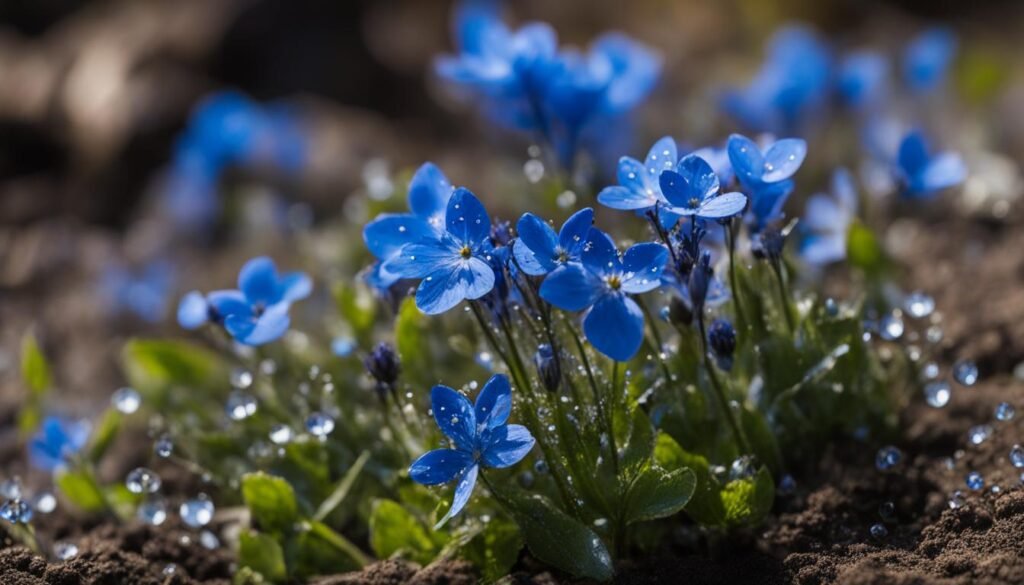
The Hardy Hibiscus
The hardy hibiscus, or Rose mallow, is known for its strikingly beautiful flowers that come in various shades of blue. These flowers can thrive in wet soil conditions and are sure to catch the eye of anyone passing by. The large, showy blooms of the hardy hibiscus make it a perfect choice for adding a pop of blue to your garden.
The Swamp Sunflower
The swamp sunflower, or Helianthus angustifolius, is another blue annual that can thrive in moist ground. This flower produces clusters of bright blue flowers that resemble the sunflower. The vibrant blue blooms of the swamp sunflower can add a cheerful and lively touch to your garden, even in wet soil conditions.
“The hardy hibiscus and swamp sunflower are both excellent choices for gardeners looking to add blue annuals to their wet soil gardens. These flowers not only provide a burst of color but also offer a unique beauty that can truly transform your outdoor space.” – I
By choosing these blue annuals for your garden, you can enjoy both their stunning beauty and their ability to thrive in moist ground. Whether it’s the large, showy blooms of the hardy hibiscus or the vibrant clusters of the swamp sunflower, these flowers are sure to create a captivating and colorful display in your wet soil garden.
| Blue Annual | Characteristics |
|---|---|
| Hardy Hibiscus | Large, showy blooms |
| Swamp Sunflower | Clusters of vibrant blue flowers |
Blue Shade Plants for Damp Soil
If you have a shady area with damp soil, there are blue shade plants that can thrive in these conditions. These plants not only tolerate moist soil but also produce beautiful blue blooms, adding a touch of elegance to your shady garden.
Japanese Iris
One stunning blue shade plant for damp soil is the Japanese iris. With its delicate petals and vibrant blue color, the Japanese iris is a true showstopper. This perennial plant is well-adapted to wet conditions and can thrive in the shady corners of your garden. Its tall, graceful stalks and captivating flowers make it a standout feature in any landscape.
The Japanese iris is available in a variety of blue shades, ranging from pale powder blue to deep indigo. Its unique form and striking appearance make it a popular choice amongst gardeners looking to add a touch of sophistication to their damp, shady areas.
Swamp Milkweed
Another excellent option for blue shade plants in damp soil is the swamp milkweed. This native perennial is known for its vibrant blue flowers and ability to thrive in moist conditions. The swamp milkweed adds both color and texture to your garden, with its clusters of small, star-shaped blooms and slender, elongated leaves.
In addition to its aesthetic appeal, the swamp milkweed also attracts pollinators such as butterflies and bees. By planting this blue shade plant in your shady garden, you can create a vibrant, wildlife-friendly habitat.
“The Japanese iris and swamp milkweed are two standout blue shade plants that can bring beauty and elegance to your damp, shady garden. Their ability to thrive in moist conditions makes them the perfect choice for adding blue blooms to your landscape.” – [Your Name]
To help you visualize the beauty of these blue shade plants, here is an image of the Japanese iris in full bloom:
With their striking blue hues and adaptability to damp soil, the Japanese iris and swamp milkweed are fantastic choices for adding a splash of color to your shady garden. These blue shade plants will not only thrive but also captivate and inspire with their stunning blooms.
Ground Covers with Blue Flowers for Wet Soil
When it comes to covering large areas of wet soil, ground covers are both practical and aesthetically pleasing. They not only help prevent erosion but also add a touch of beauty to your garden. If you’re looking to introduce blue flowers to your moist garden, consider the following ground covers that thrive in wet soil:
1. Periwinkle
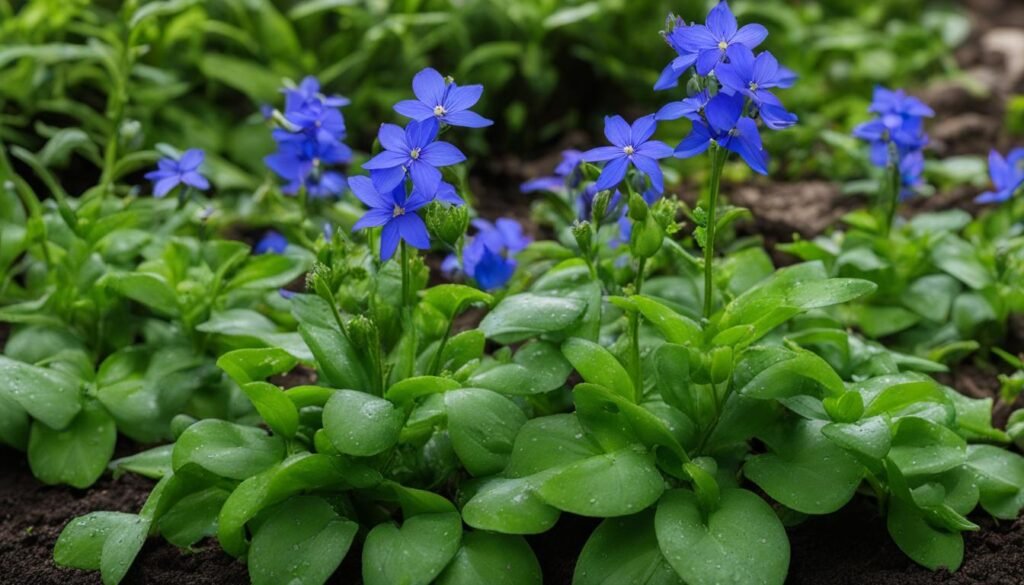
Periwinkle (Vinca minor) is a popular ground cover known for its beautiful blue flowers. This low-growing plant forms a dense carpet of glossy green leaves with delicate blue flowers that bloom from spring to summer. Periwinkle is ideal for areas with consistent moisture and partial shade.
2. Blue Star Creeper
Another fantastic choice for wet soil is Blue Star Creeper (Isotoma fluviatilis). This ground cover features tiny star-shaped flowers in shades of blue and forms a dense mat of foliage. Blue Star Creeper thrives in moist conditions and is perfect for between stepping stones or in perennial borders.
Both periwinkle and blue star creeper are excellent options for creating a stunning visual display of blue flowers in your garden. Their ability to tolerate wet soil conditions makes them the perfect choice for damp areas.
Benefits of Ground Covers:
“Ground covers are not only visually appealing but also provide various benefits to your garden. Some advantages of using ground covers include:”
- Preventing soil erosion
- Suppressing weeds
- Conserving moisture in the soil
- Improving soil structure
- Reducing the need for mowing or maintenance
- Creating a polished and cohesive look to your garden
| Ground Cover | Scientific Name | Preferred Growing Conditions | Flower Color |
|---|---|---|---|
| Periwinkle | Vinca minor | Moist soil, partial shade | Blue |
| Blue Star Creeper | Isotoma fluviatilis | Moist soil, full sun to partial shade | Blue |
Blue Flowers for Wet Soil in Containers
If you have wet soil conditions but still want to enjoy the beauty of blue flowers, planting in containers is a great solution. You can create a stunning container garden with blue flowering plants that thrive in moist soil. Two excellent options for blue flowers in containers with wet conditions are papyrus and pickerel weed.
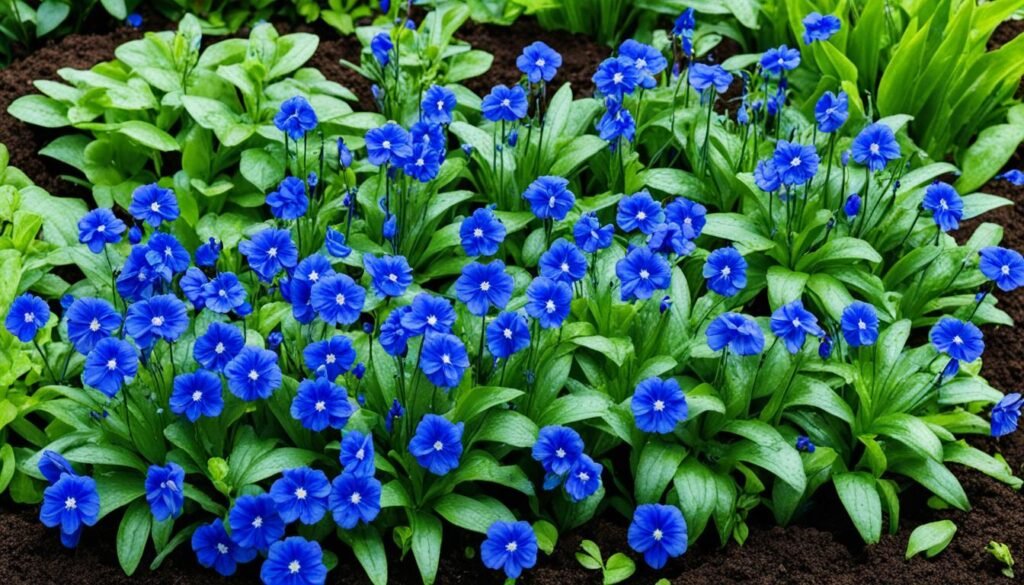
Papyrus is a unique and eye-catching plant that adds a touch of elegance to any container garden. Its tall stalks and feather-like leaves create a statement piece, while the blue flowers add a pop of color. Papyrus is well-suited for moist soil conditions and can tolerate standing water in containers.
Pickerel weed is another excellent choice for containers with wet soil. This plant features striking blue flowers that bloom atop tall stems, creating a dramatic effect. The foliage of pickerel weed also adds visual interest with its glossy green leaves. It thrives in moist soil and can be a beautiful addition to your container garden.
The combination of papyrus and pickerel weed in a container creates a visually appealing contrast between the tall, elegant stalks of papyrus and the striking blue flowers of pickerel weed. This dynamic duo adds a touch of sophistication and natural beauty to any outdoor space.
Tips for Growing Blue Flowers in Containers with Moist Soil
If you’re planning to grow blue flowers in containers with wet soil, here are some helpful tips to ensure their success:
- Choose containers with adequate drainage holes to prevent waterlogging.
- Use a well-draining potting mix that retains moisture without becoming waterlogged.
- Place the containers in a location that receives partial sun to full sun, depending on the specific plant’s requirements.
- Water the plants regularly, keeping the soil consistently moist but not soaked.
- Fertilize the plants according to their specific needs to promote healthy growth and vibrant blooms.
By following these tips and selecting the right blue flowering plants for containers, you can create an attractive and thriving container garden with blue flowers, even in wet soil conditions.
How to Care for Blue Flowers in Wet Soil
Caring for blue flowers in wet soil is essential to ensure their healthy growth and vibrant blooms. Follow these tips to keep your blue flowers thriving in damp conditions:
- Provide adequate drainage: Blue flowers in wet soil can suffer from root rot if waterlogged. Make sure the soil has proper drainage to prevent excessive water accumulation that may harm the plants. Consider improving the soil structure by incorporating organic matter or creating raised beds.
- Mulch to maintain moisture: Apply a layer of organic mulch around the base of your blue flowers. This will help retain moisture in the soil and reduce weed growth. Organic mulch such as shredded bark or compost also adds nutrients to the soil over time.
- Regular watering: While blue flowers in wet soil benefit from moisture, it’s important to strike a balance. Check the moisture level of the soil regularly and water only when needed. Avoid overwatering, as it may lead to root rot. Ensure the soil remains consistently moist but not waterlogged.
- Fertilize appropriately: Blue flowers in wet soil may require regular fertilization to maintain healthy growth. Choose a balanced liquid fertilizer or slow-release granules specifically formulated for flowering plants. Follow the package instructions for application rates and frequency.
Proper care for blue flowers in wet soil ensures their thriving growth and vibrant blooms. Adequate drainage, mulching, regular watering, and appropriate fertilization are key to their success.
Here’s an example of a care routine for blue flowers in wet soil:
| Task | Frequency |
|---|---|
| Check soil moisture | Once a week |
| Watering | When soil is dry 1-2 inches deep |
| Mulching | Once a year, in spring |
| Fertilization | Every 4-6 weeks during the growing season |
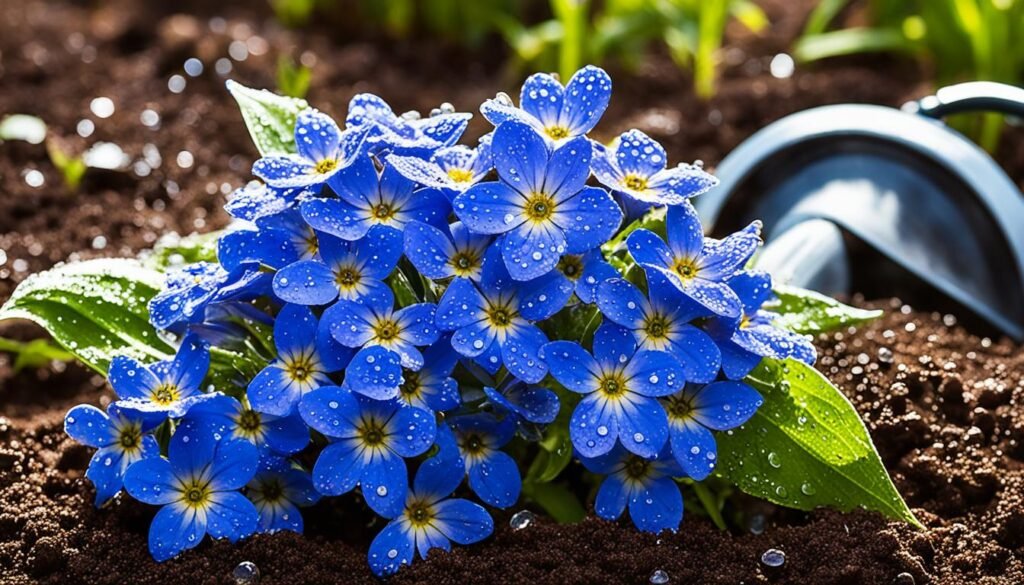
With these care tips and a little attention, your blue flowers in wet soil will flourish and add a touch of serenity and beauty to your garden.
Best Companion Plants for Blue Flowers in Wet Soil
Pairing blue flowers with companion plants can enhance the beauty of your garden. When it comes to blue flowers in wet soil, there are several companion plants that grow well together and create a visually pleasing display. To complement the vibrant blue hues, consider adding white-flowering varieties such as ‘Annabelle’ hydrangeas or columbines.
The contrasting colors of blue and white can create a stunning visual impact, adding depth and interest to your garden. These companion plants not only enhance the aesthetic appeal but also provide a harmonious balance to the blue flowers.
Here are two great companion plants for blue flowers in wet soil:
1. ‘Annabelle’ Hydrangeas
Scientific Name: Hydrangea arborescens ‘Annabelle’
Plant Type: Shrub
Hardiness Zone: 3-9
Description: ‘Annabelle’ hydrangeas are known for their large, round clusters of white flowers. They can thrive in wet soil conditions and provide a beautiful contrast when paired with blue flowers. These hydrangeas bloom in summer and can add a touch of elegance to any garden.
2. Columbines
Scientific Name: Aquilegia
Plant Type: Perennial
Hardiness Zone: Varies by species
Description: Columbines are delicate, bell-shaped flowers that come in a variety of colors, including white. They can grow well alongside blue flowering plants in wet soil and create a charming and whimsical garden display. Columbines bloom in spring and early summer, adding a burst of color to your landscape.
By pairing blue flowers with companion plants such as ‘Annabelle’ hydrangeas or columbines, you can create a dynamic and harmonious garden that will be the envy of your neighbors. The contrasting colors and textures can elevate your garden’s aesthetic appeal and provide a captivating visual experience.
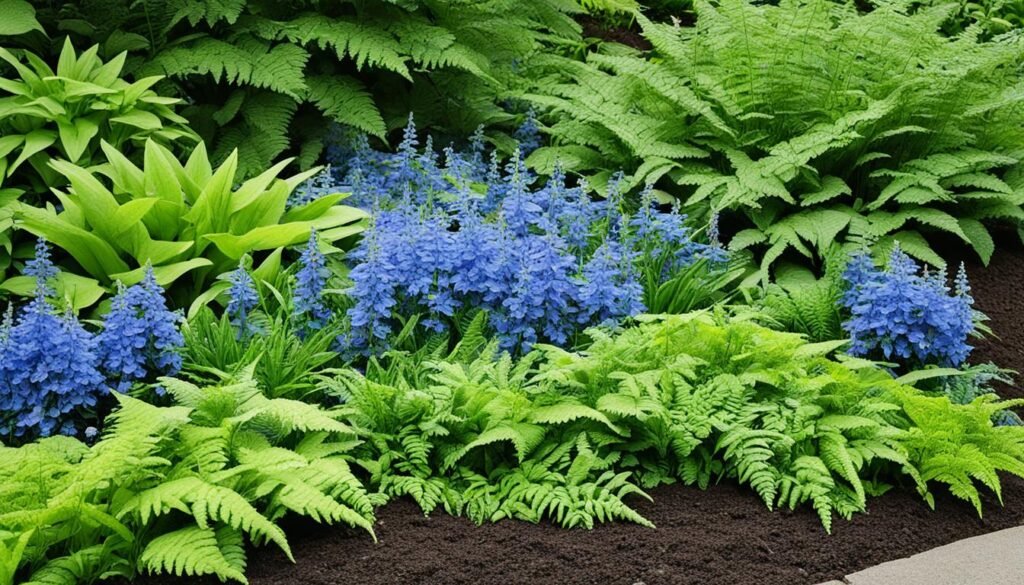
Design Ideas for Blue Flowers in Wet Soil
When it comes to designing your garden with blue flowers in wet soil, the possibilities are endless. The vibrant blue hues can add a striking contrast against the green foliage, creating a visually stunning landscape. Here are some design ideas to inspire your blue flower garden:
1. Create Beautiful Borders
Utilize blue flowering plants to create eye-catching borders in your garden. Plant blue asters or bluebeard along the edges of your flower beds to frame your garden and add a pop of color. The bold blue flowers will stand out against the wet soil, creating a captivating display.
2. Fill in Empty Spaces
If you have any empty spaces in your garden, consider filling them with blue flowering plants. Blue forget-me-nots or lobelias can thrive in wet soil conditions and fill those gaps with their delicate blue blooms. The contrast between the blue flowers and the wet soil will bring life to previously barren areas.
3. Add Focal Points
Create focal points in your garden using blue flowers in wet soil. Plant tall blue delphiniums or hydrangeas at strategic locations to draw attention and add a touch of elegance. These statement plants will serve as focal points and anchor the overall design of your garden.
4. Combine Complementary Colors
Pair blue flowers with complementary colors to create visually pleasing combinations. Plant blue salvias alongside yellow coreopsis or orange marigolds to create a vibrant and harmonious color palette. This interplay of colors will enhance the beauty of your garden and create a captivating visual impact.
5. Incorporate Blue Ground Covers
Enhance the texture and depth of your garden by incorporating blue flowering ground covers. Plant blue star creepers or blue ground phlox to create a sea of blue flowers that spread across your wet soil. These low-growing ground covers will not only add visual interest but also help retain moisture in the soil.
“Designing with blue flowers in wet soil allows for endless creativity and visual impact. The contrast between the vibrant blue hues and the damp soil creates a unique and captivating garden design.” – Gardening Enthusiast
By implementing these design ideas, you can create a stunning garden with blue flowers that thrive in wet soil conditions. The key is to experiment with different combinations, textures, and heights to achieve a visually appealing and harmonious landscape.
| Design Idea | Description |
|---|---|
| Create Beautiful Borders | Plant blue asters or bluebeard along the edges of your flower beds to frame your garden and add a pop of color. |
| Fill in Empty Spaces | Use blue forget-me-nots or lobelias to fill any empty spaces in your garden and bring life to previously barren areas. |
| Add Focal Points | Plant tall blue delphiniums or hydrangeas at strategic locations to create focal points and anchor the overall design of your garden. |
| Combine Complementary Colors | Pair blue flowers with complementary colors like yellow coreopsis or orange marigolds to create visually pleasing combinations. |
| Incorporate Blue Ground Covers | Plant blue star creepers or blue ground phlox to enhance the texture and depth of your garden. |
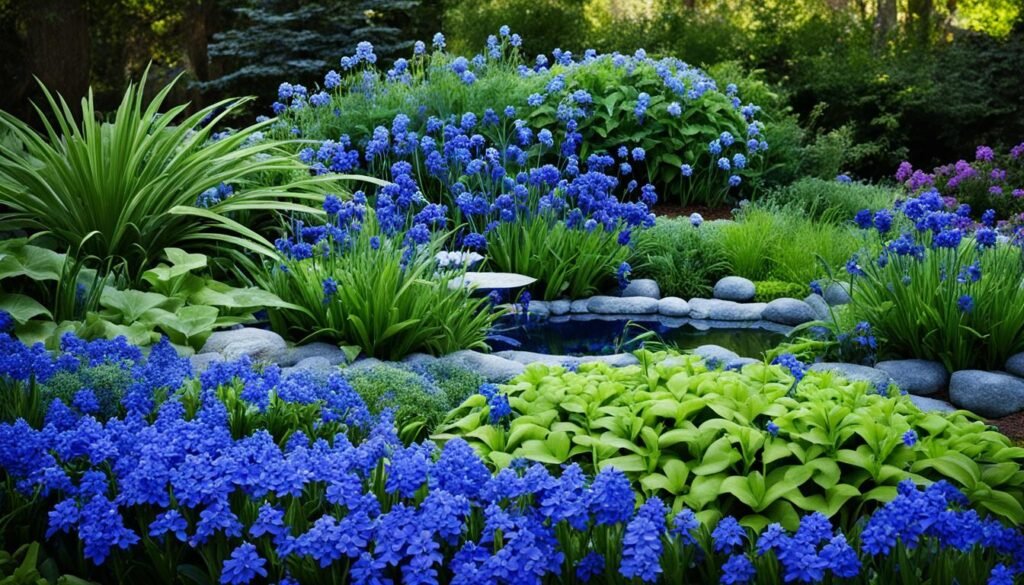
Benefits of Blue Flowers in Wet Soil
Growing blue flowers in wet soil can bring numerous benefits to your garden. Not only do they add a vibrant pop of color, but they also offer unique advantages that make them worth considering. Here are some of the benefits of cultivating blue flowers in moist conditions:
1. Calming and Soothing Atmosphere
The serene blue hues of these flowers have a calming effect, creating a tranquil and soothing atmosphere in your garden. Blue is often associated with relaxation, peace, and tranquility, making it the perfect choice for creating a serene outdoor space where you can unwind and enjoy nature.
2. Attract Pollinators
Blue flowers are known to attract pollinators such as butterflies and hummingbirds. These beautiful creatures are not only fascinating to observe but also play a crucial role in the pollination process. By planting blue flowers in your wet soil garden, you can invite these delightful pollinators to visit and bring life and vibrancy to your landscape.
| Blue Flower | Scientific Name | Benefits |
|---|---|---|
| Forget-Me-Not | Myosotis | The tiny blue flowers create a carpet of color and attract bees. |
| Lobelia | Lobelia | Produces a profusion of blue flowers and attracts butterflies. |
| Hydrangea | Hydrangea macrophylla | The blue varieties add a stunning focal point to your garden. |
| Delphinium | Delphinium | Tall spikes of blue flowers create a dramatic visual impact. |
“Blue flowers in wet soil not only provide aesthetic beauty but also bring various benefits such as attracting pollinators and creating a tranquil ambiance.” – Gardening Enthusiast
With their calming presence and ability to attract pollinators, blue flowers can be the perfect addition to your wet soil garden. Whether you choose forget-me-nots, lobelias, hydrangeas, or delphiniums, these beautiful blue blooms will add charm and vibrancy to your landscape. Embrace the benefits of blue flowers in moist conditions and transform your garden into a haven of serenity and natural beauty.
Blue Flowers for Wet Soil: Planting Tips
When it comes to planting blue flowers in wet soil, there are a few important factors to consider. By following these planting tips, you can ensure that your blue flowering plants thrive in moist conditions.
Choose the Right Location
Before planting blue flowers in wet soil, it’s essential to choose a location that provides the right amount of sunlight. Most blue flowers prefer full sun to part shade, so make sure the chosen spot receives at least six hours of direct sunlight per day. This will help the plants grow and bloom to their full potential.
Ensure Good Drainage
While blue flowers can tolerate wet soil, it’s crucial to ensure proper drainage to prevent waterlogging. One way to improve drainage is by amending the soil with organic matter, such as compost or well-rotted manure. This will help to create a looser soil structure and improve water movement.
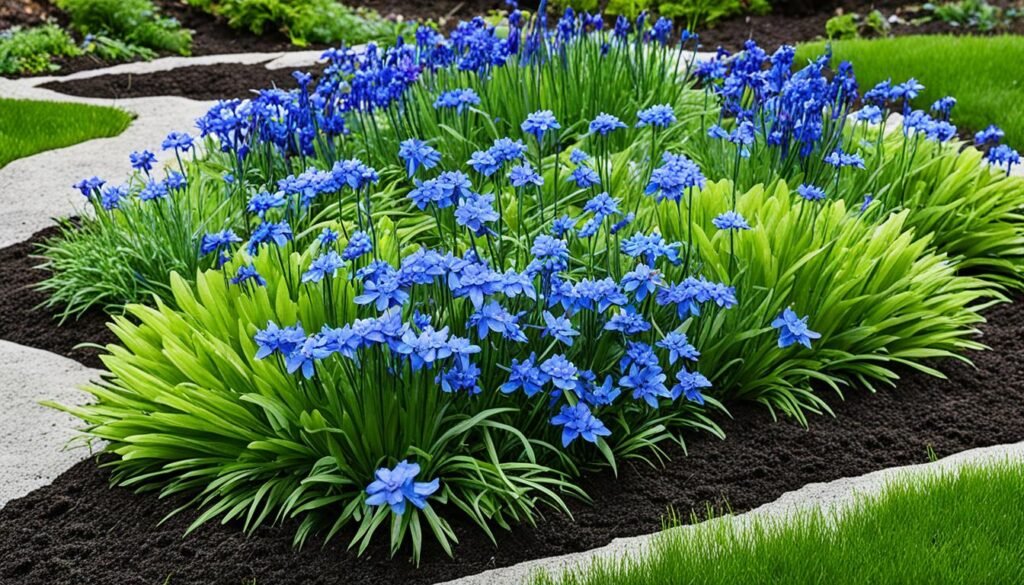
Plant at the Right Depth and Spacing
When planting blue flowers in wet soil, it’s essential to follow the recommended planting depth and spacing for each specific plant. Planting too deep or too close together can impede growth and development. Refer to the plant’s label or consult a gardening guide for specific instructions.
Regularly Water to Maintain Moist Soil
Although the soil is already moist, it’s important to water blue flowers regularly to keep the soil consistently moist. Avoid overwatering, as this can lead to root rot and other issues. Aim to keep the soil evenly damp, allowing it to dry out slightly between waterings.
“Proper planting and care techniques are crucial for the successful growth of blue flowers in wet soil.”
By following these planting tips, you can create a stunning display of blue flowers in your damp or wet garden. With the right location, proper drainage, appropriate planting depth and spacing, and regular watering, your blue flowering plants will thrive in moist soil conditions.
Conclusion
Blue flowers have the power to transform your garden, even in wet soil conditions. With a wide variety of options to choose from, including perennials, annuals, ground covers, and container plants, you can create a vibrant oasis that brings tranquility and beauty to your outdoor space.
By following proper planting and care techniques, you can ensure the success of your blue flowers in moist or damp soil. Adequate drainage, regular watering, and mulching are key factors to consider when growing blue flowers. Additionally, selecting companion plants that complement the blue blooms can enhance the overall aesthetic appeal of your garden.
Not only do blue flowers add visual appeal, but they also offer numerous benefits. Their calming effect creates a soothing atmosphere, while attracting pollinators like butterflies and hummingbirds, bringing life and vibrancy to your landscape. Whether you prefer delicate blue periwinkles, bold cardinal flowers, or low-growing blue star creepers, these blue beauties will make a striking statement in your wet or damp garden.

